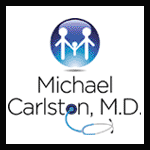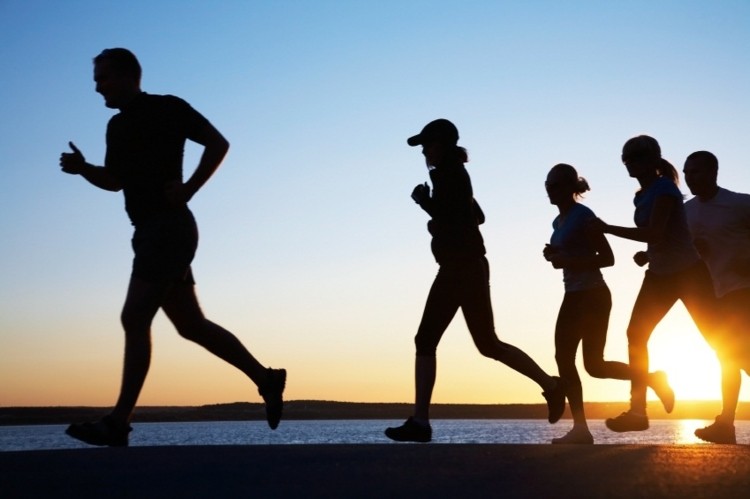Sports Medicine
(Dr. Carlston pictured above at Olympic Marathon trials.)
Michael Carlston, M.D. – Sports Medicine bio
(click to view 1-page .pdf)

August 2013 — (A letter of mine)
Dear Santa Rosa Marathon Runners,
Another year, just another race? Nope. There are similarities, but differences too, making every year and every race special.
Like last year, I want to make the race experience better and safer for you. I also want to keep you out of the medical tent and make the aid stations just refreshing stops to pick up refreshments and applause.
After working at many endurance events over the years, I can confidently say that we have an excellent staff, even remarkably so for a race of this size. As the race medical director, recruiting and developing quality staff to be there IN CASE you need us may well be the most important part of my job. Last year was better than the year before. This year should be much better still.
Before I remind you about some measures you should take to keep yourself out of the medical tent, I want to mention some changes.
The single loop course should be great, but it presents a few more challenges for you and for us. We have a few more aid stations to staff (9 instead of 5). The DeLoach segment will be fun, but keep your eyes open as you wind around the property and through the barrel room. You might be tempted to stop, but keep on running and go back later with your finisher’s medal.
Again we will have paramedics (and maybe other medical staff) patrolling the course on bicycles, as well as first aid coordinators at the aid stations. Their responsibilities will be to identify runners needing medical assistance, provide some minimal care as necessary, and in consultation with me at the medical tent, arrange additional medical services for runners as required. Like the finish line medical tent staff, the first aid coordinators will be readily identifiable by their brightly colored t -shirts.
At the aid stations we will post flags indicating the risk posed by the weather, so that you can pace yourself accordingly. We will follow established guidelines for those flags (green, yellow, red and black). The course is almost as flat as in the past, largely shaded and graced by the practically idyllic climate of Santa Rosa. So, I cannot imagine you will ever see a black flag. A black flag means that the weather conditions are so dangerous that we need to cancel the race. There is an excellent chance that you will only see green flags, but if you see yellow or red ones, recognize that the conditions are less than ideal, potentially threatening, and adjust your pace accordingly. We will have ice at the aid stations as well as the finish line.
will follow established guidelines for those flags (green, yellow, red and black). The course is almost as flat as in the past, largely shaded and graced by the practically idyllic climate of Santa Rosa. So, I cannot imagine you will ever see a black flag. A black flag means that the weather conditions are so dangerous that we need to cancel the race. There is an excellent chance that you will only see green flags, but if you see yellow or red ones, recognize that the conditions are less than ideal, potentially threatening, and adjust your pace accordingly. We will have ice at the aid stations as well as the finish line.
Following guidelines established at the Twin Cities Marathon, we have an Impaired Runner Policy we will follow on race day. It is as follows:
Medical personnel are authorized to remove from the race course any runner deemed medically impaired without an automatic disqualification. To be allowed to continue the race a runner must:
a) be able to proceed in a straight path toward the finish line;
b) be able to explain who they are, where they are on the course, and what they are doing;
c) look clinically fit to proceed, with good skin color and body appearance;
d) be able to maintain a reasonable running posture
Running a marathon poses an extreme physical and mental challenge. That is probably why you are running it. However, a few simple preparations will improve your performance, your overall experience, help you recover faster and keep you out of the finish line medical tent.
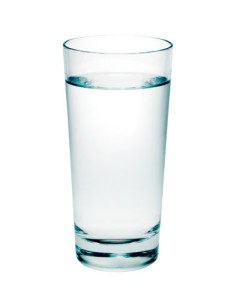 Day in and day out in my office I nag my patients about drinking enough water. That is because I have seen inadequate water intake create major health impacts on hundreds, if not thousands of patients. Many runners begin a race dehydrated, putting themselves at a competitive disadvantage. Alcohol dries you out and weakens your muscles. We are proud of our local wine industry, but try to limit your wine tasting the two days prior to the race. Hydrating in the days leading up to the race is wise. That will help you perform better, make you more resistant to the heat and lower the risk of some of the most serious problems that marathon runners experience.
Day in and day out in my office I nag my patients about drinking enough water. That is because I have seen inadequate water intake create major health impacts on hundreds, if not thousands of patients. Many runners begin a race dehydrated, putting themselves at a competitive disadvantage. Alcohol dries you out and weakens your muscles. We are proud of our local wine industry, but try to limit your wine tasting the two days prior to the race. Hydrating in the days leading up to the race is wise. That will help you perform better, make you more resistant to the heat and lower the risk of some of the most serious problems that marathon runners experience.
Race day is different. Under the physiologic stresses of a marathon, your kidney function drops. While that conveniently limits your need for rest stops, it is also potentially extremely dangerous. If you drink a lot during the race and your kidneys have slowed down, the water content of your blood will rise, diluting the electrolytes essential to life. Drinking sports drinks can boost performance over plain water, but they do not appear to be any less dangerous in this way. After running 26.2 miles and burning off thousands of calories, runners with this problem usually gain weight. The problem, exertional hyponatremia, kills a small number of marathon runners every year. The longer you are on the course and the more you drink, the more you are at risk.
What do you do? The easiest approach is to drink at the first 2-3 aid stations and then drink when you are thirsty afterwards. Even if they don’t prevent serious hyponatremia, sports drink are a better choice during the race than water. Many experienced endurance athletes use their weight as a good to proper race hydration, planning to lose 2-3 pounds by the finish. We can also use your weight to help figure out what is wrong if you end up in the medical tent.
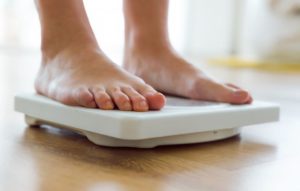 For example, one of the athletes I took care of at the Vineman Ironman Triathlon this year had gained 7 pounds! Obviously not good and he felt as bad as you might expect. LOTS of salt, a few hours, nothing to drink and urinating off 4 pounds later he was good to go home.
For example, one of the athletes I took care of at the Vineman Ironman Triathlon this year had gained 7 pounds! Obviously not good and he felt as bad as you might expect. LOTS of salt, a few hours, nothing to drink and urinating off 4 pounds later he was good to go home.
If you can, weigh yourself the morning of the race. I will also have a scale in my booth at the prerace expo.
Another factor increases the risk of hyponatremia and other serious medical problems in marathon runners. That is using ibuprofen. As I told dozens of runners last year, we do not hand out ibuprofen at the race for this reason. That is now the standard at the major US marathons. We know better.
Endurance events, like running a marathon break down muscles. Extreme muscle damage (rhabdomyolysis) can occur and, although usually minor, it can also be lethal. Statins, warm weather and alcohol increase the risk of this problem. At each of the last two events I worked (San Francisco Marathon and Vineman Ironman Triathlon) I took care of a runner with rhabdomyolysis. None of you, okay? Although statin drugs increase the risk of rhabdomyolysis, talk to your doctor about going off of them for the week before the race before stopping them.
If you hurt yourself, straining any muscles in the week or two prior to the race, be careful about how fast you run the race. That is not just because of the risk of re-injury or another injury because your stride will be different from before. An injury also increases your risk of other, more serious problems. Go ahead and run if you are up to it, but avoid getting caught up in the excitement and running faster than you anticipated.
That advice is actually wise for every runner. When you are very near the limits of your ability, pushing harder is potentially dangerous, even life threatening. If you want to run another day, do not overdo it. There is truth in the tale of the first marathon runner, Pheidippides, with the heroic but unhappy ending. Don’t go there.
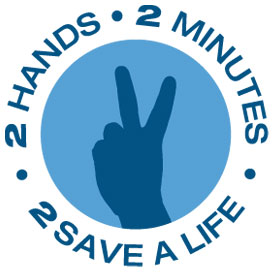 Returning runners will remember the Hands Only CPR program we started last year. I wanted to start it last year after talking to friends at the Boston Marathon who started it there. With every race I work I think about what happened there this year and the many heroes who stepped forward to help those who were injured. In the spirit of helping each other out, we are continuing the Hands Only CPR.
Returning runners will remember the Hands Only CPR program we started last year. I wanted to start it last year after talking to friends at the Boston Marathon who started it there. With every race I work I think about what happened there this year and the many heroes who stepped forward to help those who were injured. In the spirit of helping each other out, we are continuing the Hands Only CPR.
As you are unfortunately aware, we know that all of us, even marathon runners, eventually die, and heart disease, the biggest killer in the US, is a likely cause. Your running will probably delay it for years, but if you are going to have a heart attack, it is likely to hit while you are running. Most people who die of heart disease just collapse and are gone. We call it Sudden Cardiac Death (SCD). 85% of those who collapse from a cardiac arrest, die. That statistic has not changed in a generation. We can change that.
When a person has a sudden cardiac event and someone calls 911, the victim has less than a 10% chance of leaving the hospital alive. If that same bystander calls 911 but then provides the simplest form of CPR, using chest compressions alone, that victims chances jump up to 30%. In a way, the BEST CPR, the kinds provided by EMTs, doctors and nurses, isn’t. Waiting does not work. If YOU give it a try, that victim has a chance. If you don’t, they don’t.
We are training our nonmedical volunteers in Hands Only CPR. During both days of the expo we will have HO CPR training available at no charge to you, your family and friends. At the finish line festival, we will have HO CPR training again available at no cost to you, your family and friends.
You can see who has gone through our HO CPR training by looking for the orange wristband they will be wearing. The wristbands say “I CAN SAVE A LIFE”. PLEASE consider attending one of the sessions. Please ask your support team to do the same. Wear your wrist band on race day. If you just can’t give up the 15 minutes the HO CPR will take, go to our website and check out the HO CPR links. The videos are fun and SHORT, like two to three minutes. There are even apps for iPhones and Android.
I will have a booth at the pre-race expo. Come by and visit me. I will be happy to answer your questions, especially any that might keep you OUT of the medical tent!
Best,
Michael Carlston, MD
© 2018 - 2019, Michael Carlston, M.D. All rights reserved.
Website designed by Renaissance Consultations
